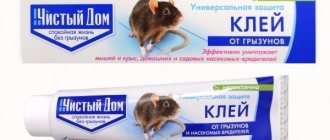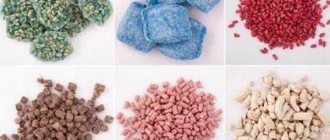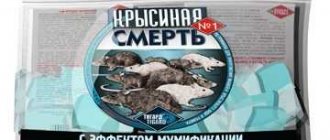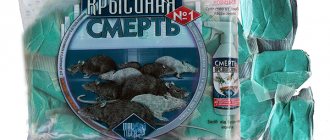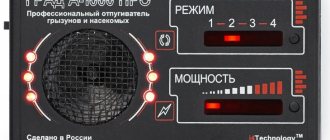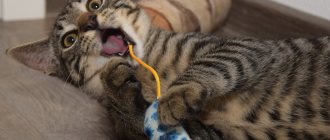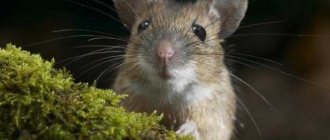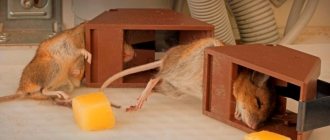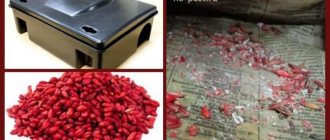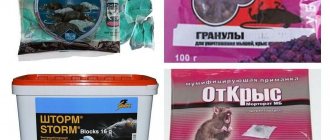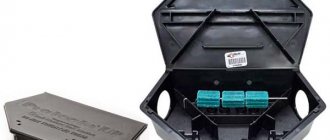When a problem arises related to the extermination of rodent pests, many questions cannot be avoided. Which poison is better to order? The choice of means to combat rats in our time is very diverse. There are powders, gels, briquette baits and many other options for destruction. In order to save your precious time, money and nerves, we suggest you immediately contact our online store. Only now you can buy Rat Death No. 1 and save significantly on rodenticides!
Safety
Keep traps as far away from food and pet food as possible. You can only lay out bags with dough-like mass while wearing gloves and using tweezers. If you do not follow this rule, then there is a risk of poisoning. Another important factor is that traps should not contain human odor, to which rats and mice are overly susceptible.
Avoid any contact with rodenticide if you are prone to frequent allergic reactions. If signs of poisoning appear, consult a doctor immediately.
General information
Rats, moving around the apartment, can spoil food and contaminate them and surfaces with their waste products. They can also chew furniture and electrical wiring, which can lead to fires.
IMPORTANT! The greatest harm from rats may lie in their ability to carry diseases that are very serious for humans, which include plague, leptospirosis, hemorrhagic fever, and rabies.
For this reason, you cannot hesitate when fighting rats, otherwise you can expose yourself and your household to great risk.
Operating principle and release form
The described drug is produced in Ukraine using raw materials from Italy. It is capable of destroying both mice and rats.
The product is available in two forms, which are quite effective. The characteristics of both forms of this drug are described in the table:
| Category | "Rat Death" | |
| Number 1 | Number 2 | |
| Main active ingredient | Brodifacoum is an anticoagulant that inhibits blood clotting | Bromodiolone is a more powerful anticoagulant |
| Toxicity level | Average | High |
| Appearance | Blue-green substance | Red substance |
| Lethal dose for one individual | 2 g | 6 g |
| Date of death | 4-8 days | |
| Danger to the environment | Very high | Average |
Although the drugs have different active ingredients, both are effective and give equally good results.
REFERENCE! There is another version of the drug on sale, which is presented in the form of glue. Rat death glue is sold in tubes of 135 g. It differs in that it can only fight mice.
Other components
The drug “Rat Death” is produced in the form of briquettes with a dough-like structure. They are packaged in special bags that allow odors to pass through well. Due to the fact that the active ingredients have no aroma, the composition contains special additives that help attract rats. These include:
- flour;
- sugar;
- vegetable oil;
— flavors of natural origin.
REFERENCE! According to reviews, the described drug has a mummification effect. But the manufacturer himself does not talk about this, and the drug does not contain the corresponding substances.
Conclusion
Poisons are an effective means of controlling rodents. Facts about them:
- Poisons for mice differ in the way they affect the body. Blood anticoagulants cause internal and external bleeding, leading to death. Other organic poisons cause suffocation and infect with pathogenic bacteria.
- Inorganic pesticides have a highly toxic effect not only on rodents, but also on other animals and humans. They are prohibited for home use.
- You can make homemade poison for mice at home or purchase it at a store or veterinary pharmacy.
- Highly toxic poisons are prohibited for use.
- Mice must be poisoned in compliance with safety measures.
- The most effective poisons cause 100% lethality in rodents.
Rodenticides can be used to kill and prevent rodents.
How to use rat and mouse poisons with anticoagulants
Despite the absence of mummifying agents in the compositions, anticoagulants speed up the drying process of corpses. An anticoagulant is a drug that interferes with blood clotting and prevents the formation of platelets. The impact on the body causes profuse internal bleeding - severe blood loss significantly reduces the percentage of fluid content, the corpse dries out much faster. It is this effect of anticoagulants that manufacturers of mouse poison present as mummification.
Individuals that have eaten bait with poison return to the nest and slowly die within 10 days. Due to the low moisture content, the tissues of the corpse dry quickly, there is no smell, the problem of decomposition is eliminated, the owner is satisfied. Moreover, rats do not associate effect and cause, and since the animal does not emit an odor, the bait can be scattered again until the next generation of rats with immunity to poisons grows up.
Basic safety requirements:
- The drugs are extremely toxic, so they are laid out on a substrate in the form of cardboard or a lid. It is prohibited to place bags on the floor.
- You cannot touch poisons with your hands; they can only be removed with tweezers and gloves.
- The poison for mice is laid out like this - divide the bag in half, carry it at a distance of 5 m. For rats, take 1 bag for each hole, carry it at a distance of up to 10 m.
- The bait is checked daily and refilled. If poison is used in the house, it is left out only at night.
- A week after applying the first dose, inspect secluded places for rodent corpses. The remains are destroyed by burning or buried in the ground.
- Bait is placed in hard-to-reach places, placed in boxes or containers. This makes it more likely that the rat will not get out of the container; you won’t have to look for it behind the walls, etc.
Particular caution is needed in families with children and pets. An attractive smell can provoke a test, and this is fraught with irreversible consequences. At the slightest suspicion of poisoning, you must immediately call an ambulance and consult a veterinarian.
Signs of human poisoning:
- vomiting, nausea, abdominal pain, diarrhea, headaches;
- impaired hearing and vision, loss of orientation in space;
- blue lips, pale skin;
- weakness, decreased blood pressure;
- increased heart rate;
- the appearance of blood from the gums and nose;
- blood in feces, urine.
First aid for the victim is gastric lavage. Drink up to 1.5 liters of water and induce vomiting. While the ambulance is on its way, the rinsing is done three times. If the estimated time for the poison to enter the body exceeds 10 minutes, take activated carbon at the rate of 1 tablet per 10 kg of person’s weight. To speed up the action of the sorbent, grind the tablet into powder and give it to drink.
Don't hesitate to call for help. Service phone number 112, 103. A person with a diseased liver, gastrointestinal dysfunction, or a child cannot survive without doctors; the use of anticoagulants is extremely dangerous.
Types of poisons
Rodents can be poisoned with organic and inorganic substances. The difference lies in the main component, which was obtained from natural elements or chemically.
Blood anticoagulants
Poisons are classified as chronic drugs. Characterized by a long latent period. The composition of the drugs contains substances that block blood clotting.
How does the poison affect mice?
- poisons accumulate in the body and lead to pathological processes;
- after eating rodenticides, the death of the animal occurs within 3-10 days from internal bleeding.
The remedies are effective due to their delayed action (individuals do not feel danger from the bait, eat it themselves and bring other individuals).
Advantages of anticoagulants:
- small doses of 0.00025-0.005% are used (safe for animals if accidentally ingested);
- do not cause a protective reaction in rodents;
- There are different types (food baits, foams, sticky coating).
Rodenticides can be used for preventative purposes.
Important! Residues of poisons and carcasses of dead animals should not be thrown into trash containers. Disposal is carried out by burying (to a depth of 0.5 m) or burning.
Rat Death #1
The toxic component is brodifacoum. Food additives (sunflower oil, flour, flavorings) mask the smell of poison. The release form is square film bags filled with a green-blue plastic mass.
Brodifacoum does not have volatile properties. The substance is dangerous only if it enters the body of an individual.
Lethal dose: for a mouse - 0.24 g, for a rat - 2 g.
Goliath
The active ingredient is flocumafen, a coumarin derivative. Has selective toxicity (mice, rats). Without a pronounced smell or taste, therefore it is easily masked by food additives and flavorings.
Lethal dose (LD): 0.25 mg/kg body weight for rats, 0.8 mg for mice.
The second generation rodenticide is dangerous for dogs (LD 0.075-0.25 mg/kg), does not affect aquatic life, and is low toxic to birds.
Storm
The active component of all forms of poison is flocumafen. Additional components of baits are grains, flavors, wax (for briquettes). The water-soluble dye Bitrex in the composition is needed as a protective measure. When it comes into contact with skin or mucous surfaces, it leaves a blue stain.
Lethal dose: mice - 0.8 mg, rats - 0.25 mg.
Rat Death #2
The drug is produced by Ukrainian companies under the Italian brand Dr. Tezza. Release form: filter bags with a poisonous red paste (raw meat).
The active ingredient is bromadiolone, a second generation anticoagulant. Accumulates in the liver, slows down the production of prothrombin. Additional components - flavoring and aromatic additives. To prevent pets from swallowing the bait, bitterness is added to the poison.
Usage algorithm:
- Filter bags are laid out in places where rodents live, along the route of movement. Dose calculation - 1 pc. for mice, 2-3 for rats.
- For bait, use closed containers where only rodents can enter.
- Take the bags with tweezers or hands wearing rubber gloves.
Bromadiolone can penetrate the skin. Therefore, if it gets on open areas of the body, they must be washed with running water and soap.
Lethal dosages (mg/kg): rats - 0.49-1.125, mice - 1.75, dogs - 8.1-10, cats - 25.
Efa
Active ingredient: ethylphenacin 0.015% (briquettes), bromadiolone 0.005% (grain baits, gel).
The principle of action of the drug is to damage the walls of blood vessels. Available in the form of grain coated with a poisonous component and paraffin briquettes. Excipients: cereal, sunflower oil, flavorings.
Lethal dose of ethylphenacin: for mice - 5000 mg/kg, for rats - 940 mg/kg. For domestic animals and birds, the toxic effect is less pronounced. The lethal portion for them is 7-70 g/kg.
Zookoumarin Neo
The product is available in the form of purple grains or cereals, pink granules. An aromatic additive is used to attract rodents. The bitter taste should repel non-target animals and people.
Active ingredients: zoocoumarin 0.005% (first generation), bromadiolone 0.005%. The biological effectiveness of the product is 100% for rats (7-11 days), 80% for mice (8-22 days).
Lethal dosage for rats is 4.650 mg/kg.
Baits with an anticoagulant effect have proven themselves well. They can be used in everyday life, in enterprises, in healthcare institutions, and catering.
Another effective remedy is the combination drug “Ratobor”. It also gets rid of water rats.
The products are ready for use without additional processing. The substances do not have volatile properties and have a toxic effect after entering the stomach.
Other organic poisons
Poisons that cause suffocation help kill rodents.
Krysid is a drug based on alpha-naphthylthiourea (1%). The substance quickly reduces the level of hemoglobin in the blood, which leads to respiratory failure and death of the rodent. It is an acute poison with selective toxicity.
Lethal outcome occurs at a dosage of 14.1 mg for rats, 400 mg for mice. When absorbed through the skin of a rat, the death of the individual occurs at an amount of 50 mg/kg.
Available in the form of a gel or odorless grain bait. Biological effectiveness is 70% death of rats.
Application procedure:
- Rodents are fed for 3-7 days (without using poisons).
- Then the bait is changed to Rasid (50-100 g).
- After 3-4 days, the remaining substance is removed.
The drug must be alternated with other poisons against representatives of the mouse family. The effectiveness of the substance decreases with frequent use. Pests develop resistance to it.
The biological agent Bactorodencid has shown good effectiveness in the fight against rodents. The active substance is pathogenic bacteria (Salmonella enteritidis, var. Issatschenko). They cause diseases of the digestive system, which lead to the death of the individual after 5-7 days. Sick animals infect the entire colony.
Available in the form of grain bait.
Mode of application:
- The product is placed near the holes (5 g) in bait containers.
- Treatment is carried out every 10-14 days.
Used in warehouses, granaries.
Advantage: it affects only members of the mouse family. It has no toxic effect on other animals or humans.
Inorganic poison
Chemical poisons for rodent control contain metal phosphides (zinc, aluminum, magnesium). A toxic effect occurs when the substance enters the stomach (upon contact with hydrochloric acid).
Rodenticides are volatile and can be dangerous to pets and humans. Preparations containing heavy metals are prohibited for household use.
Fumiphos
The product is used for processing grain in warehouses.
The active ingredient is aluminum phosphide (560 g/kg). When interacting with atmospheric moisture, it releases phosphine gas, which is a fumigant. Available in tablet form.
Fumiphos is a highly toxic substance. Specially trained personnel can work with it.
Composition of the drug
Rat Death poison is available in two forms - Rat Death 1, Rat Death 2. The main difference is in the active ingredient. The first drug uses brodifacoum, the second - bromadiolone.
Brodifacoum is more toxic; a small dose is enough to poison an animal. Bromadiolone acts more slowly, but the results are impressive.
The first drug is released in blue-green tones, the second one resembles pieces of meat. The following are used as auxiliary components:
- flour;
- vegetable oil;
- nutritional supplements;
- flavorings.
The toxic substance does not reveal itself in any way. Rats eat the bait with great eagerness and a huge appetite. Since the product does not begin to act immediately, pests do not see anything suspicious in the treat. All that remains is to add more poison to the rats and wait for the result.
Prohibited poisons
Pesticides that threaten the life and health of people and harm the environment are included in the “black” list. Among them:
- Arsenic is a substance that depresses the nervous system and causes severe pain in the digestive tract. Provokes paralysis, pulmonary edema, coma.
- Strychnine - causes paralysis of the respiratory center, which leads to death.
- Yellow phosphorus - when it enters the body, it affects the circulatory system, brain, and liver.
- Lead - accumulates in bones, damages the brain and kidneys. High doses of metal lead to death.
The use of these substances in rodent control is prohibited in many countries.
Threat to humans
One way or another, rat poison is dangerous for humans, although the degree of intoxication of the body depends on a number of factors. For example:
- On the degree of toxicity of the main toxic components.
- From the general state of human health.
- From the age of the victim.
- From the dose of poison that entered the body.
- From the functioning of the liver.
In any case, when handling poison, you need to take care of your health by using personal protective equipment. To do this, you need to wear rubber gloves, and while working you should not smoke, eat, or touch your face with your hands. At the end of the action, it is better to remove and throw away the gloves, and wash your hands and face with soap and water.
The most important thing is to ensure that the poison does not enter the stomach. If intoxication occurs, the person soon develops headache, dizziness, nausea, vomiting and even loss of consciousness. When working with anticoagulants, negative symptoms appear much more slowly, which is no less dangerous, since a person may not associate negative symptoms with poisoning with a rodent poison.
As a rule, people are poisoned by rat poison either accidentally or intentionally. Only children are poisoned by accident, but adults can do it intentionally.
First generation poisons have a high degree of toxicity, so poisoning with them often leads to death. A person can get poisoned when he ignores safety measures. The most important thing is to store toxic substances in hard-to-reach places so that children and pets cannot get to them.
In order not to risk your health again, you can seek help from specialists who practice exterminating rats. Unfortunately, this type of service is not cheap.
What happens if you EAT RAT POISON
Watch this video on YouTube
What is a rodent poison with a mummifying effect?
Mummification is a process in which the tissues of a corpse dry out rather than decompose. This occurs under the influence of natural factors (mummies in tombs) or is a consequence of special drugs. Poison for rats with a mummifying effect is a relatively recent offering on the market. According to the manufacturers, the composition not only poisons the animal, but also promotes drying of tissues in the absence of corpse odors and miasmas of decomposition.
Manufacturers claim that due to the absence of the smell of a corpse, the rat poison does not repel living rodents. And this is, perhaps, one of the main advantages, since experienced summer residents know that rats are smart and will not “peck” at poisonous bait again. If one individual dies, emitting miasma, the rest of the rats will no longer touch the poison. The intelligence of school animals forces them to periodically remove dead individuals and change the bait. And if the poison for rats with a mummifying effect meets all the stated characteristics, it will put an end to the eternal struggle between man and rodent.
Providing assistance in case of poisoning
It is almost impossible to get poisoned by the drug Rat Death by inhaling its smell, since it has no odor. But if handled carelessly, the product may end up in:
- on the skin;
- into the stomach.
If the drug gets into the gastrointestinal tract, you should immediately induce vomiting, take activated carbon in the amount of 10-20 tablets and a saline laxative (1 tablespoon of Glauber's salt per glass of water). In case of contact with skin, wash the contaminated area with soap or a 0.2% solution of potassium permanganate. After the assistance provided, you must go to a medical institution, where the victim will be examined and vitamins of group “K” will be given as an antidote to this poison.
How does rat death affect rats?
The active ingredients of this drug are rodenticides that have an anticoagulant effect. It turns out that the principle of their operation is absolutely the same. The difference between them is that drug No. 1 will have to be used in larger quantities than No. 2.
The principle of action of the drug is described below:
- Appetizing bait. The drug contains substances that lure rats with their aroma. Since the poison contains very little toxic substance, it is not detected by the sensitive receptors of rodents. Having smelled the bait, they calmly eat it.
- Intoxication. The poison enters the liver and blocks the synthesis of vitamin K, which is responsible for blood clotting.
- Deadly influence. The poison that enters the body is not excreted in the urine, gradually accumulating in it. Then the outpouring of blood into the internal organs of the rodent begins.
- Death. After about 3-4 days, a lethal dose accumulates in the body, leading to the death of the rat.
One of the main advantages of this drug is its delayed action.
REFERENCE! Rats are very intelligent creatures. If they had compared the death of a relative with the effect of the poison they had eaten, they would never have touched it again. Due to the fact that “Rat Death” does not act instantly, rats calmly continue to eat it. For this reason, this drug is a fairly effective poison for rats.
Instructions for using the poison
The drug is ready for use immediately after purchase, which is another advantage. The fact that the poison does not need to be prepared or mixed in any way reduces the risk of human intoxication. But before using poison, you still need to learn about some nuances.
How to apply it correctly?
The rules for using agents used to poison rodents are different for all drugs.
Lures are:
- Ready-made grain mixtures with the addition of toxic substances, briquettes, granules, foam. Even a beginner can use them - the poison is simply laid out around the room in rat habitats.
- Requiring preparation - concentrates that require special preparation to work with.
Baits are prepared in a separate room in compliance with safety precautions. Solutions are made in an enamel container intended only for these purposes. Opened poisons and ready-made baits must be stored in a cool place, protected from light, under lock and key.
The finished poison is laid out in accordance with the instructions in the instructions and the number of pests. Grains, granules and briquettes are placed in portions of 10-15 grams at a distance of 3-8 meters from each other. It is better to choose places near burrows, cracks in the floor, and near drinking bowls.
If you are going to poison rats outside, the poison will need to be placed directly into the holes. When using foam, it is recommended to cover the hole with earth so that the substance is not washed out by rain.
For bait, it is better to use peanut butter, chocolate, bread or cotton wool.
Please note - it is better to lay out poison and set traps in the evening due to the increased activity of rodents in the dark
Precautionary measures
When starting to work with poisons, you should first carefully study the instructions. When using this product, you must adhere to the safety rules described below:
- Briefing. This drug should not be used by persons under 18 years of age or by pregnant or breastfeeding women. In addition, it should not be used by people with blood or liver diseases.
- Informing. All persons living in the area, including neighbors, must be informed about the decomposition of the poison. This is done to eliminate the risk of accidental poisoning.
- Removal of children and pets. If there are children and pets in the room, they must be evacuated during treatment, because it is completely impossible to protect them.
- Protective means. The entire processing process must be carried out in special clothing and rubber gloves to completely prevent skin contact with the substance. It is best to spread the bait using tweezers or a plastic spoon, which you then discard.
- Eating food is strictly prohibited while bait is being laid out, as is drinking or smoking.
- Cleaning. You can only clean up leftover grass and rat corpses while wearing rubber gloves. All collected dead rodents and open briquettes with poison must be burned or buried in the ground to a depth of at least 1 meter.
IMPORTANT! It is strictly forbidden to throw away poison residues and rat carcasses into a regular trash container. This is because stray cats, dogs or birds can find and eat them.
Release form
Poison Rat death
The effectiveness of the poison largely depends on the form of release. Rat Death is produced in the form of a gel-like substance. It is given the appearance of a briquette and packed in filtered paper. Placed in a polymer film. Poison in bags is stored for 3 years from the date of manufacture.
On a note!
A special gel base prevents the product from losing its properties while remaining on the floor surface for a long time. Sun rays and high temperature do not affect the appearance of the drug. The recommended period for using printed briquettes is 2 weeks.
An effective rat repellent can be purchased at any specialty store at an affordable price. The package contains 8 briquettes weighing 100 g, or 16 pieces with a total weight of 200 g. The active composition of the rat repellent and the successful release form have made the poison in demand on the market for similar products.
